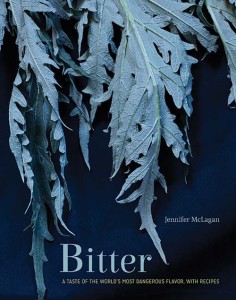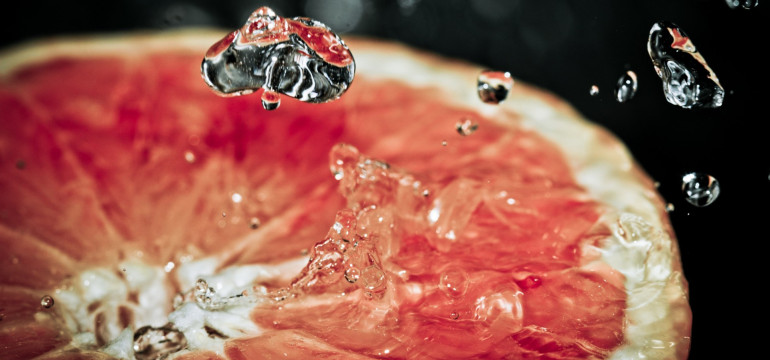By: Kelsey Tenney

source: www.jennifermclagan.com
Jennifer McLagan has become a renowned food writer and voice for unpopular ingredients. She highlights scary elements like bones, “odd bits”, and fat which earned her a James Beard Award. With a background in the restaurant world as a chef, McLagan aims to put unappreciated and therefore unfamiliar ingredients into home cooking in a non-threatening way. By giving histories, anecdotes, and recipes, McLagan’s cookbooks are highly regarded as brilliant and original bringing to the table completely new and inspired ideas. In her most recent cookbook, Bitter, McLagan set out to highlight the often forgotten and misunderstood taste, but why is bitter so off-putting? And what is it? While it is not completely clear, bitter is most commonly attributed to evolution.
Evolutionarily, humans have learned to survive by consuming as much nutrient-dense food as possible. It makes sense then that foods rich in fats (9 cal/g) and sugars (4 cal/g) are so appealing to us. You can see this evolutionary trait in action if you observe a baby’s first taste of cake or ice cream—instant bliss. In addition to figuring out what to eat, humans learned what they had to avoid to survive. Harmful compounds like some secondary plant metabolites, rancid fats, and most importantly almost all naturally occurring environmental toxins have a very bitter taste. Because of this trend, scientists have attributed the bitter taste to being a defense mechanism against poisons. Plants have also evolved to become more bitter, discouraging their consumption.
Avoiding poisons is more important to survival than finding enough calories in a day, so there was much more emphasis on detection of bitter than any other taste. Consequently there is a large variety of compounds recognized by the tongue and brain as bitter, even though they are diverse in chemical structure. Taste receptors on the tongue are responsible for recognizing compounds as sweet, salty, bitter, savory, and sour. These receptors are located in taste buds that have four different classes of cell type. Type two cells are responsible for detecting bitter, sweet, and savory. While sweet and umami tastes have just one coded receptor each, bitter is encoded by at least 25 different genes on several chromosomes.
Believe it or not, this is relatively small compared to other mammals. Mice and other primates all have substantially more genes for bitter perception (at least 40). Classically, this difference is understood as evolution as a response to cooking. Cassava root, for example, is poisonous while raw producing cyanide in the body. Cooked, however, cassava root becomes tapioca. Anthropologists have differing opinions on the exact time when cooking became a part of the ancient human diet, but conservatively, evidence strongly supporting its use dates back to one million years ago—the homo erectus period. Cooking freed up nutrients in food that our body could not utilize “raw.” This allowed for extra calories and a larger energy budget assisting mainly in the growth of the brain. Cooking also resulted in detoxification of foods making it less necessary to have so many poison alert systems.

source: www.theglobeandmail.com
Aside from warning us of potential intoxication, bitter can be very pleasant and sought after in products like coffee and beer. Not surprisingly, these foods have to be learned to be appreciated. One way that has been shown to improve liking for a particular taste is simply repeated exposure. Increased sensory rating for sugar jellies can be tracked over increased consumption. Research has shown that bitter takes a much larger amount of exposure events than sweet because of its overall “unpleasantness.” Something that can help you enjoy bitter more quickly is a novel introduction of the taste. I’m sure we can all remember sitting at the kitchen table as a child being told “you’re not allowed to leave this table until you finish your vegetables” by your parent. The bitter taste of that vegetable combined with the horrid situation has conditioned you to swear that Brussels sprouts are your mortal enemy. McLagan tackles this concept by introducing completely different sources of bitter than you might expect. While she includes common foods like grapefruit and tea, she also has several recipes to help you appreciate other, more unfamiliar, sources of bitter like cardoons or white asparagus.
It appears as though bitter is becoming trendy through the massive craft beer movement and the appearance of the simple kale salad on every restaurant menu. Conversely, McLagan’s Bitter highlights this “dangerous” taste in salads, tarts, and entrees in a thoughtful way that I hope is here to stay. My personal favorites include the chocolate tobacco truffles and grapefruit curd. Bitter, when carefully added to our foods, balances out the overall flavors. You’ll begin to wonder what’s missing from your pizza after enjoying the effects of bitter—ah maybe it’s because you’re remembering just how lovely that arugula pizza was from chapter three. Happy bitter tasting!
 About Kelsey: I grew up in Minnesota constantly in awe of innovative companies like General Mills and Cargill. After touring Cargill kitchens in high school, I decided food science was my niche. I received my Bachelor’s from Purdue University and continued on to The Pennsylvania State University where I am working on a Master’s concentrating in food chemistry. In my free time I love to bake and cook in order to experience food science in all its glory. I recently started the blog www.appeasingafoodgeek.comdetailing my culinary adventures. When I’m not in the lab you can usually find me multitasking between testing a cookie recipe, watching an old episode of X Files, and trying to find my wine glass.
About Kelsey: I grew up in Minnesota constantly in awe of innovative companies like General Mills and Cargill. After touring Cargill kitchens in high school, I decided food science was my niche. I received my Bachelor’s from Purdue University and continued on to The Pennsylvania State University where I am working on a Master’s concentrating in food chemistry. In my free time I love to bake and cook in order to experience food science in all its glory. I recently started the blog www.appeasingafoodgeek.comdetailing my culinary adventures. When I’m not in the lab you can usually find me multitasking between testing a cookie recipe, watching an old episode of X Files, and trying to find my wine glass.
References
Jha, A. 2012. Scientists find clue to human evolution’s burning question. The Guardian. Retrieved from http://www.theguardian.com/science/2012/apr/02/scientists-clue-human-evolution-question.
Coupland, J.N., Hayes, J.E. 2014. Physical approaches to masking bitter taste: lessons from food and pharmaceuticals. Pharmaceutical Research, 31 (11): 2921-2939.
Mela, D.J. 2000. Why do we like what we like? Journal of the Science of Food and Agriculture, 81: 10-16.
Wolfgang, M., Behrens, M., Brockhoff, A., Bufe, B., Kuhn, C. 2005. Human bitter taste perception. Chemical Senses, 30: i14-i15.
Cover Image: www.miriadna.com






Hi Kelsey, thanks for another great read! Personally I have never liked bitter foods (it may be because of the brussels sprout incident you spoke about in your article), but after reading this post and developing more of an understanding of why this might be, I am interested in trying to expand my horizons a little bit. I would love to look at some of the recipe’s in this book and try a few of them out, but to start off with, do you have any recommendations as to what bitter foods I could try to start the process?
Hey Kelly! Thank you so much for the comment. I really appreciate your kind words! Bitter by Jennifer McLagan has actually just been nominated for a James Beard Award, so I would recommend checking it out! In the meantime, I think roasted vegetables like carrots and turnips are great. The carrots are sweet and the turnips are bitter while the roasting gives that browned note. I still can’t handle really bitter greens like kale, but I’ve heard fatty dressings and nuts make a great salad and balance the bitter. You could also just start toasting your bread longer so that it burns a little.